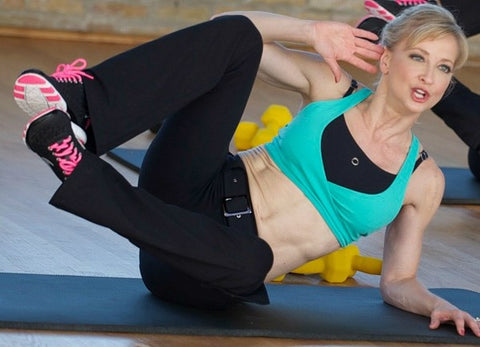Flexible Mind, Flexible Body
by Angie Miller
 I see it all the time… It's the end of class, and just as I'm ready to finish with what I think is the best part of the workout, the ending stretch sequence, there's a few individuals who hustle out of the room as if those final 3-5 minutes are critical to their day. Maybe once in awhile that's true, but before you decide to skip the stretch at the end of your next workout, I think it's important to weigh the benefits of a 5 minute head start on errands, dinner, or whatever it may be, vs. the benefits of 5 minutes of proper stretching.
I see it all the time… It's the end of class, and just as I'm ready to finish with what I think is the best part of the workout, the ending stretch sequence, there's a few individuals who hustle out of the room as if those final 3-5 minutes are critical to their day. Maybe once in awhile that's true, but before you decide to skip the stretch at the end of your next workout, I think it's important to weigh the benefits of a 5 minute head start on errands, dinner, or whatever it may be, vs. the benefits of 5 minutes of proper stretching.
Know this… skipping the ending stretch after you've just sweated to your favorite exercise DVD, taken a run, or even a long walk, can cause muscle imbalances that result in injury, less effective movement patterns, and in my opinion a less productive workout overall. Just as a flexible mindset can help up to embrace concepts and ideas that are outside of our usual way of thinking, a flexible body can help us to embrace exercises and activities we might not otherwise be able to perform.

So the next time you're tempted to skimp on your stretch, here are three reasons to remain flexible:
- Stretching improves mobility:
Your joints allow you to move. Whether it's reaching down to pick up your baby, or racing around your neighborhood on your morning jog, stretching helps you to maintain joint mobility. If your range of motion is limited because you have tight muscles, this will affect your workouts and your everyday movements.
- Stretching improves posture and balance:
Stretching can help you maintain a good balance of muscle strength and muscle flexibility, which is important for proper posture and alignment. A common imbalance for many of us is tight hip flexors, (front of the hips), from sitting down much of the day. This tightness can cause your lower back to sway as your pelvis is pulled forward. Any imbalance like this alters your posture and affects the quality of your movement, which can have a negative impact on your balance. The goal is to be able to move freely in your daily activity and to have proper range of motion as you exercise. Stretching will keep your joints mobile and improve your overall posture and body alignment.
- Stretching helps relax your muscles and relieve your stress:
After sitting at a desk in front of a computer all day, or sitting at an event for an extended period of time, doesn’t it feel amazing to stand up and stretch? When we sit in one position for too long, or work the same muscles over and over again, aka repetitive movement, our muscles get tight and knotted. Stress also has an impact, as it causes more tension throughout our body. Stretching can help counterbalance the stiffness and tension by increasing blood flow to the affected muscles and stimulating the nervous system to decrease stress hormones. All of this results in a calmer, more relaxed physical state.
When it comes to stretching, the term “use it or lose it” really does apply. Good body mechanics, improved range of motion, healthy posture and alignment, and better balance all result from proper stretching and flexibility.
Here’s to stretching your limits~
Best in Health,
Angie
Angie Miller, M.S., is a fitness educator, university instructor, and Licensed Professional Counselor who blends her skills and expertise to empower individuals, mentally and physically, and provide them the tools they need to succeed. A veteran group exercise instructor and personal trainer, Angie is the star of acclaimed exercise DVD’s, including the Bedroom Body™ workout. Her passion for progressive education brought her to Northern Illinois University, where she teaches in the Dept. of Kinesiology & Physical Education. Outside of the university, she presents at fitness conventions worldwide and leads industry trainings as an AFAA Certification Specialist and Kettlebell Concepts Master Instructor. Angie writes for fitness journals and digital communities, and blogs for Collage Video. Connect with Angie at: http://www.angiemillerfitness.com




















